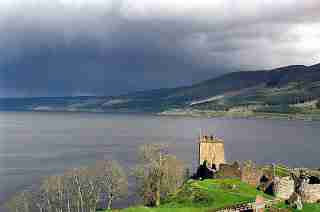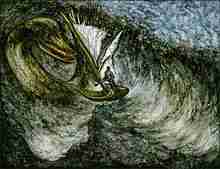<< Exercices du forum || En bas
Le monstre du Loch Ness (thème)
Message de notrepere posté le 29-09-2010 à 02:01:27 (S | E | F)
 Bonjour à tous!
Bonjour à tous!
Here is a small diversion about the Loch Ness Monster (en avez-vous entendu parler?). The Loch Ness Monster continues to be one of the most intriguing mysteries of all time. Merci à lucile83 qui m'a beaucoup aidé.
1. S'il vous plaît, traduisez le texte suivant en anglais. (Please translate the following text into English.)
2. « Cryptozoologie : qu'est-ce que ça veut dire ? » Ecrivez une ou deux phrases concernant ce sujet en anglais.
..................................................
Le monstre du Loch Ness

Le monstre du Loch Ness est un animal imaginaire, non identifié par rapport à une famille ou à une espèce, mais on prétend qu'il habite l'Ecosse et son Loch Ness. Le monstre du Loch Ness est l'un des animaux les plus connus étudiés par la cryptozoologie. La croyance et l'intérêt populaires pour l'animal ont diminué et se sont affaiblis au cours des années depuis que l'animal a été révélé au monde en 1933. L'évidence de son existence est en grande partie anecdotique, avec du matériel contesté et photographique minimal et beaucoup de lecture de sonar : il n'y a eu aucune évidence physique (restes de squelette, capture d'un animal vivant, échantillons ou traces de tissu organique ). Les habitants de la région, et plus tard beaucoup de gens dans le monde, ont affectueusement appelé l'animal par un diminutif : Nessie (Gaélique écossais: « Niseag ») depuis les années 50.
..................................................
Merci pour votre participation et bonne chance!
-------------------
Modifié par notrepere le 07-10-2010 07:32
Since there were so few responses, and the responses that were posted were of such high quality, I have decided not to spend time on a correction. Congratulations to all the participants! I'll see you around...
Message de notrepere posté le 29-09-2010 à 02:01:27 (S | E | F)
 Bonjour à tous!
Bonjour à tous! Here is a small diversion about the Loch Ness Monster (en avez-vous entendu parler?). The Loch Ness Monster continues to be one of the most intriguing mysteries of all time. Merci à lucile83 qui m'a beaucoup aidé.
1. S'il vous plaît, traduisez le texte suivant en anglais. (Please translate the following text into English.)
2. « Cryptozoologie : qu'est-ce que ça veut dire ? » Ecrivez une ou deux phrases concernant ce sujet en anglais.
..................................................
Le monstre du Loch Ness

Le monstre du Loch Ness est un animal imaginaire, non identifié par rapport à une famille ou à une espèce, mais on prétend qu'il habite l'Ecosse et son Loch Ness. Le monstre du Loch Ness est l'un des animaux les plus connus étudiés par la cryptozoologie. La croyance et l'intérêt populaires pour l'animal ont diminué et se sont affaiblis au cours des années depuis que l'animal a été révélé au monde en 1933. L'évidence de son existence est en grande partie anecdotique, avec du matériel contesté et photographique minimal et beaucoup de lecture de sonar : il n'y a eu aucune évidence physique (restes de squelette, capture d'un animal vivant, échantillons ou traces de tissu organique ). Les habitants de la région, et plus tard beaucoup de gens dans le monde, ont affectueusement appelé l'animal par un diminutif : Nessie (Gaélique écossais: « Niseag ») depuis les années 50.
..................................................
Merci pour votre participation et bonne chance!
-------------------
Modifié par notrepere le 07-10-2010 07:32
Since there were so few responses, and the responses that were posted were of such high quality, I have decided not to spend time on a correction. Congratulations to all the participants! I'll see you around...
Réponse: Le monstre du Loch Ness (thème) de taconnet, postée le 29-09-2010 à 12:41:26 (S | E)
Bonjour Notrepère.
The Loch Ness Monster
The Loch Ness Monster is an imaginary creature which shows no similarity with any known species. It is alleged that it inhabits Loch Ness in Scotland.
The Loch Ness Monster is one of the most famous animals studied in cryptozoology.
Popular interest and belief in the animal has fluctuated since it was brought to the world's attention in 1933.
The proof of its existence is mainly anecdotal: we possess only a few photographs hotly disputed and some sonar readings.
Truth to tell, there is no tangible proof: (remains of skeletons, capture of a living animal, samples or traces of organic tissue.)
Local Scottish highlanders, and later many people around the world, have affectionately referred to the creature by the feminine nickname of Nessie(Scottish Gaelic Niseag) since the 1950s.
What does cryptozoology mean ?
Cryptozoology is the study of animals that are presumed to exist, but for which conclusive proof is missing.
The term also includes the study of animals generally considered extinct, but which are still occasionally reported.
Those who study or search for such animals are called cryptozoologists, while the hypothetical creatures involved are referred to by some as "cryptids"*, a term coined by John Wall in 1983.
*In cryptozoology, a cryptid (from the Greek "κρύπτω" (krypto) meaning "hide") is a creature whose existence has been suggested but that is unrecognized by a scientific consensus, and whose existence is moreover often regarded as highly unlikely. Noted cryptids include Bigfoot, Yeti, and the Loch Ness Monster.
Lorsque j'étais en fonction aux COMORES en 1982 j'ai découvert le COELACANTHE.
Lien Internet
Merci Notrepère.
Réponse: Le monstre du Loch Ness (thème) de violet91, postée le 29-09-2010 à 19:49:19 (S | E)
 Hello notrepère qui devrait faire un tour dans la région des Lochs..surtout du Loch Ness, le plus déroutant.
Hello notrepère qui devrait faire un tour dans la région des Lochs..surtout du Loch Ness, le plus déroutant.-- D'abord la réponse au B )(after reading wikipedia) Cryptozoology is a combination of three ancient Greek words : study of hidden animals.. so going on their tracks. Some call it a science (part of paleontology : dinosaurs)and others mysterious fascination for cryptids, hidden creatures very unlikely to exist, unsolved "legends" or myths : cyclops,the unicorn ,the Yeti or the Loch Ness monster.
Can cryptozoology be considered as rigorous or is it more or less based upon people's constant common need of imaginary trips around reality?
And now, part A
---The Loch Ness monster------
The Loch Ness monster appears to be an imaginary animal which is not classified as belonging to this or that family , this or that species, but said to be living in Loch Ness, Scotland. It is one of the most famous cryptids studied by specialists. The belief and popular interest in it have gone down and actually weakened over the years since 1933, the year when its being came to the world's ears. The proof of its existence is mostly anecdotal : very uncertain material , one or two photographs and many sonar readings. There is no evidence of its body (remains of a skeleton, capture of a living animal, samples or traces of organic tissue). The local people joined by many others coming from all over the world later on have given the creature the friendly pet name of Nessie(as for a female animal) from Gaelic Scottish "Niseag" since the 1950's.
...and the legend "must go on"..it is so good for business and tourism. Toutefois, quand le soir tard, vous vous trouvez quasiment seuls au bord du Loch immense presque aussi noir qu'une mer profonde,cernés de lourdes montagnes peu boisées, sans chants d'oiseaux dans la "nuit blanche" de cette latitude....les moindres remous au loin éveilleraient votre imagination.. Le lendemain ,tout reprend sa place et vous achetez un tee-shirt à l'effigie de Nessie pour votre enfant !

Merci notrepere de ce sujet qui sort de l'ordinaire.

Réponse: Le monstre du Loch Ness (thème) de dolfine56, postée le 30-09-2010 à 15:31:10 (S | E)
Hi, Notrepère,
Thanks for this unusual subject.
Let's plunge in one of the worldwide mysteries...
 --------
--------
-What does cryptozoology mean?
The word "cryptozoology " comes from Greek:
"kryptos ==> caché;hidden.
"zôon ==> animal;animal.
"logos" ==> sciences, sciences.
A- Cryptozoology is the study of hidden creatures,the existence of which is open to doubt,such as the "Yeti",the Monster of the Loch Ness, and other marine monsters, even disappereared animal species...
This neologism--whose definition isn't dearly established,would be, according to the big terminological dictionary,"a science which tries to study objectively the case of animals, only known by testimonies,anatomical parts or photos of debatable value."
B- The Loch Ness monster.
The Loch Ness monster is an imginary animal unidentified in comparison to a family or species, but it is said to be living in the "Loch Ness", in Scotland.
The Lock Ness monster is one of the best known animal,closely watched by the Cryptozoology.
Popular belief and interest in this animal have reduced and become weaken in the course of the years,since the animal was revealed worlwide in 1933.
The proof of his existence is, to a large extent,
anecdotal! because of a contested equipment, very few photographes,and many asdic readings:
There is no concret proof of skeleton remains, capture of living animal or samples or traces of organic tissue, discovered in 2008.
Since the fifties,the inhabitants of that area, and , later, many people all over the world,have affectionately called the creature with the pet name of "Nessie"
(from Gaelic Scottish: niseag.)
Réponse: Le monstre du Loch Ness (thème) de notrepere, postée le 30-09-2010 à 17:59:43 (S | E)
 Hello dolphine56, I love your picture...thanks for including it.
Hello dolphine56, I love your picture...thanks for including it. 
Réponse: Le monstre du Loch Ness (thème) de dolfine56, postée le 30-09-2010 à 18:42:59 (S | E)
Thanks to you, Notrepère, though it is neither moving nor handsome...!
I didn't find a better one.

Réponse: Le monstre du Loch Ness (thème) de may, postée le 02-10-2010 à 22:21:17 (S | E)
Hello notrepere,
1.
The Loch Ness monster
The Loch Ness monster is an imaginary animal, not identified by the relative of a family or a species, but one assumes that he lives in Scotland and in his Loch Ness. The Loch Ness monster is one of the most well-known animal studied by the cryptozoology. The belief and the common interest toward the animal was depreciated and was lessened by itself during the years when the animal was revealed to the world in 1933. The evidence of its existence is mainly anecdotal, with the controversial and minimal photographic material and a lot of sonar lecture: there is not any physical proof (remains of skeleton, capture of alive animal, samples or signs of organic tissue). The habitants of the region, and later many people around the world, was affectionately called the animal by a diminutive: Nessie (Scottish Gaelic: "Niseag") since the 50s.
2.
Cryptozoologie: Cryptozoology in English
Cryptozoology is the study of evidence to prove the real existence of mysterious creatures, and also in the search of hidden animals which still remain as an "unsolved mystery"

Thank you notrepere

Réponse: Le monstre du Loch Ness (thème) de notrepere, postée le 07-10-2010 à 23:57:45 (S | E)
Hello, participants. Your proposals are so good and of such high quality that I see no need for a correction. A mon avis, vous tous êtes anglophones!
 Félicitations!! I hope you had fun with the translation - and - watch out for the Loch Ness monster if you visit Loch Ness. You never know when it might make an [unexpected] appearance.
Félicitations!! I hope you had fun with the translation - and - watch out for the Loch Ness monster if you visit Loch Ness. You never know when it might make an [unexpected] appearance.  I'll see you around...
I'll see you around... 
<< Exercices du forum
